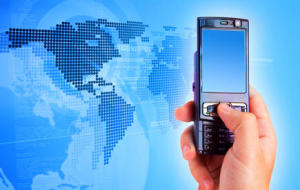
For a price of just one penny per unit the device, known as a rectenna, which is presented August 10, in IOP Publishing's journal Nanotechnology, can be placed onto objects such as price tags, logos and signage so that we can read product information on our smartphones with one simple swipe. This type of technology, which is known as near-field communication (NFC), has already been implemented to allow fast money transactions; however, this new device could lead the way to large-scale adoption at a low cost. The rectenna, created by researchers from Sunchon National University and Paru Printed Electronics Research Institute, could be implemented onto everyday objects so that they can harness the power given off by the smartphone's radio waves and send information back to it via printed digital circuits. It is called a rectenna as it is a combination of an antenna and a rectifier -- a device that converts alternating current (AC) into direct current (DC). The rectenna was printed onto plastic foils in large batches using a roll-to-roll process at a rate of 8m min-1. Five different electronic inks were used and each rectenna had a length of around 1300 mm. The researchers state that the rectenna can harness power directly from radio waves given off by a mobile phone, converting AC into DC. The rectenna created in this study could provide at least 0.3 W of power from an alternating current which had a frequency of 13.56 MHz. NFC technology is very similar to QR codes, whereby users take a photo of a square-shaped bar code on a poster or advert using their smartphone. The difference with NFC is that items will contain a small computer chip or digital information, operated by DC power. "What is great about this technique is that we can also print the digital information onto the rectenna, meaning that everything you need for wireless communication is in one place," said co-author of the study Gyoujin Cho. "Our advantage over current technology is lower cost, since we can produce a roll-to-roll printing process with high throughput in an environmentally friendly manner. Furthermore, we can integrate many extra functions without huge extra cost in the printing process. "The application of NFC technology with the smartphone will be limitless in the near future. The medical, automotive, military and aerospace industries will benefit greatly."

 Previous page
Previous page Back to top
Back to top







